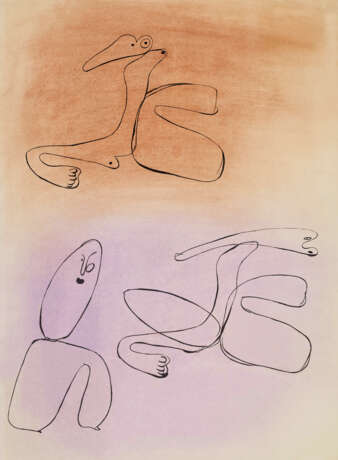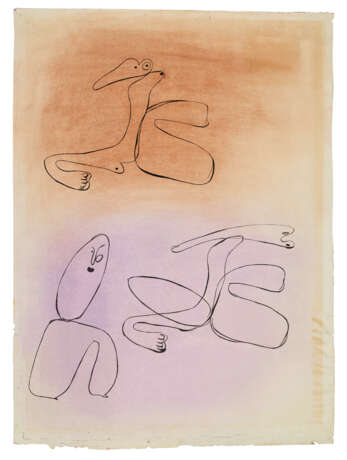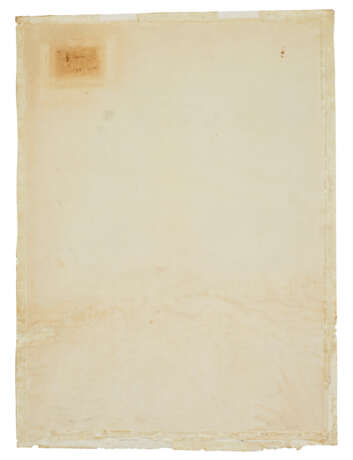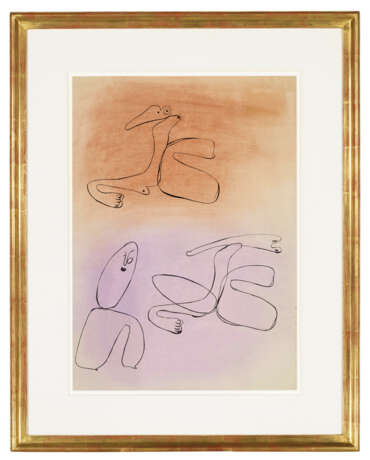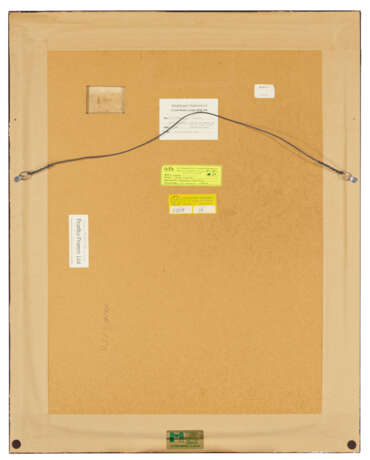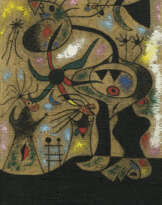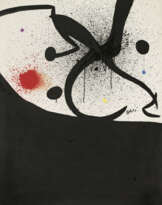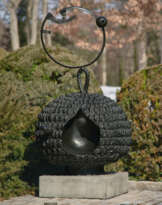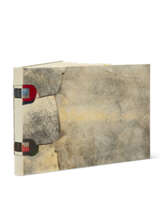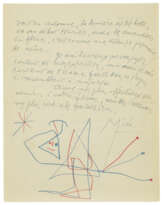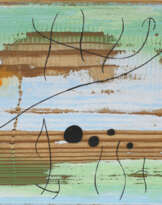ID 1178679
Los 123 | Joan Miró (1893-1983)
Schätzwert
€ 50 000 – 70 000
Sans titre
signé et daté 'Joan Miró. 15⁄2/34.' (au revers)
aquarelle, pastel et encre de Chine sur papier
63.8 x 46.6 cm.
Exécuté le 15 février 1934
signed and dated 'Joan Miró. 15⁄2/34.’ (on the reverse)
watercolour, pastel and India ink on paper
25 1⁄8 x 18 3⁄8 in.
Executed on 15 February 1934
Provenance
Galerie Gérald Cramer, Genève (en 1959).
Blanche et Harry G. Sundheim, Jr., Deerfield; vente, Sotheby Parke Bernet Inc., New York, 6 décembre 1972, lot 30.
Vente, Sotheby Parke Bernet Inc., New York, 17 mai 1979, lot 477.
Waddington Galleries, Ltd., Londres (probablement acquis au cours de cette vente).
Acquis auprès de celle-ci par le propriétaire actuel en novembre 1979.
Literature
J. Dupin et A. Lelong-Mainaud, Joan Miró, Catalogue Raisonné, Drawings, 1901-1937, Paris, 2008, vol. I, p. 200, no. 411 (illustré en couleurs, p. 201).
Exhibited
Barcelone, Fundació Joan Miró et Londres, Whitechapel Gallery, Impactes, Joan Miró, 1924-1941, novembre 1988-avril 1989, p. 126, no. 29 (illustré en couleurs, p. 59; titré 'Trois personnages').
Further details
Exécuté en 1934, pendant l'une des périodes les plus créatives et les plus intéressantes de la carrière artistique de Joan Miró, la présente œuvre témoigne de la capacité de l'artiste à transmettre l'espièglerie et le mouvement par des moyens simples mais incroyablement expressifs.
Le milieu des années 1930 est une période de grande innovation pour l'artiste, marquée par sa rupture avec les surréalistes et un nouvel intérêt politique. En 1929, Miróavait officiellement pris ses distances avec André Breton et le groupe surréaliste, dont il avait fait partie intégrante dès le début. Désireux de dépasser les limites de tout mouvement artistique établi et de tout "isme", Miró commence à chercher sa propre voie. Sa réponse réside dans sa volonté manifeste, selon ses propres termes, "d'assassiner la peinture" et de bouleverser les éléments visuels de l'art traditionnel et établi en perturbant ses compositions par l'inclusion de sujets inattendus ou l'utilisation de médiums non conventionnels.
Il n'est pas surprenant que la présente œuvre ait été réalisée quelques mois seulement avant le début de la période dite "sauvage" de l'artiste, lorsque, après avoir visité son Espagne natale, l'artiste s'est trouvé confronté à des tensions et à une instabilité politiques accrues, provoquées par les positions de plus en plus extrémistes des forces politiques de droite et de gauche dans le pays.
Les œuvres de Miro des années 1930 semblent être un dialogue tangible avec les événements politiques de l'entre-deux-guerres, en particulier ceux qui touchent son pays d'origine. Les sujets qu'il aborde à cette époque sont le reflet de cette situation politique exaspérée : il commence à peupler ses œuvres de formes monstrueuses qui confrontent le spectateur de plein fouet, à l'instar de celles qui sont en lévitation dans l'œuvre présente.
C'est dans le contexte de cette agitation politique et du manifeste post-surréaliste de l'artiste qu'il faut comprendre la présente œuvre : l'artiste s'accomode ici de son nouvel agenda artistique.La composition présente trois figures distinctes aux formes anthropomorphes curvilignes, chacune se tenant sur un fond délicatement coloré de rouge et de teintes violettes pastel. L'interaction de cette palette douce et de ces formes organiques rondes permet d'obtenir un sentiment visuel de dynamisme et de bouleversement, profondément intrinsèque à l'esthétique de l'artiste au début des années 1930. Avec une dizaine de formes fantaisistes, l'artiste parvient à créer un sentiment contagieux de jeu inattendu, sa façon personnelle d'"assassiner la peinture".
Executed in 1934, during one of the most creative and interesting periods of Miró’s artistic career, Sans Titre is a testament to the artist’s ability to convey playfulness and movement through simple yet incredibly expressive means.
The mid 1930s were a time of great innovation for the artist, marked by his rupture with the Surrealists and a newfound political interest. By 1929, Miro had officially distanced himself from André Breton and the Surrealist group, of which he had been such an integral part since its onset. Adamant on moving beyond the confines of any established artistic movement and of any ‘isms’, Miró began searching for his own new way forward. His answer lay in his overt willingness to, in his own words, ‘assassinate painting’, and upset the visual elements of traditional and established art by disrupting his compositions through the inclusion of unexpected subjects or the use of unconventional mediums.
It is no surprise that the present work was produced only a few months before the beginning of the artist’s so-called ‘wild period’, when, after visiting his native Spain, the artist encountered heightened political tensions and instability provoked by the increasingly extremist stance of both right-wing and left-wing political forces in the country.
Miro’s 1930s works seem to be in tangible dialogue with political events of the interwar years, especially those affecting his home country. His subject matter in this phase is to be understood vastly as a reflection of this exasperated political situation: he started populating his works with monstrous shapes that confront the viewer head on, not dissimilar to the ones levitating in the present work.
It is within the context of this political turmoil and the artist’s post-Surrealist manifesto that the present work should be understood: here, one can truly witness the artist come to terms with his new artistic agenda. The sheet shows three distinct figures made up of curvilinear anthropomorphic forms, each standing against a delicately colored background of blush red and pastel purple hues.
The interplay of this soft palette and these round organic shapes is used to achieve a visual sense of dynamism and upheaval that is profoundly intrinsic to the artist’s aesthetic of the early 1930s. With approximately ten whimsical shapes, the artist is able to render a contagious feeling of unexpected playfulness, his own personal way to ‘assassinate painting’.
| Künstler: | Joan Miró (1893 - 1983) |
|---|---|
| Kunst Stil: | Moderne Kunst |
| Kategorie des Auktionshauses: | Gemälde, Aquarelle, Zeichnungen, Aquarelle und Zeichnungen |
| Künstler: | Joan Miró (1893 - 1983) |
|---|---|
| Kunst Stil: | Moderne Kunst |
| Kategorie des Auktionshauses: | Gemälde, Aquarelle, Zeichnungen, Aquarelle und Zeichnungen |
| Adresse der Versteigerung |
CHRISTIE'S 9 Avenue Matignon 75008 Paris Frankreich | ||||||||||||||
|---|---|---|---|---|---|---|---|---|---|---|---|---|---|---|---|
| Vorschau |
| ||||||||||||||
| Telefon | +33 (0)1 40 76 85 85 | ||||||||||||||
| Fax | +33 (0)1 40 76 85 86 | ||||||||||||||
| Nutzungsbedingungen | Nutzungsbedingungen | ||||||||||||||
| Versand |
Postdienst Kurierdienst Selbstabholung | ||||||||||||||
| Zahlungsarten |
Banküberweisung | ||||||||||||||
| Geschäftszeiten | Geschäftszeiten
|
